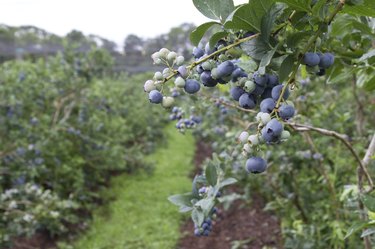
Indiana ranks 12th in commercial blueberry production in the United States, so it's clear that blueberries (Vaccinium spp.) can grow well in the state. The plant's need for acidic soil limits its ability to flourish in some parts of the state, though, and its vulnerability to injury from standing water makes growing it in clay soil a challenge. However, with proper management, it's possible to successfully grow blueberries even in Indiana clay.
Soil Amendments and pH
Video of the Day
To grow well and produce fruit, blueberries need acidic soil with a pH level in a range between 4.5 and 5.1. Some soils in northern Indiana fall into that range, but soils in much of the rest of the state are likely to have a native pH level that's not acidic enough for blueberries.
Video of the Day
Adding elemental sulfur to the soil can sufficiently lower the pH of soil that has a native pH of 6 or less. The amount of sulfur you'll need to add depends on the consistency of the soil; to lower pH by one point, clay soils will require the application of 3 pounds or more of sulfur per 100 square feet. The pH level will come down slowly, so you should apply the amendments at least six months before you're ready to plant.
Drainage and Soil Condition
Blueberries have shallow-growing roots that are easily damaged by standing water, so the bushes require sites with well-drained soil. Clay soils tend to have poor drainage compared to sandy or loamy soils, so sites with an abundance of clay might not be the ideal place to plant blueberries. To judge a site's drainage, observe it after a heavy rain; if water is still standing on the site after 24 hours, it's not a good site for blueberries.
Planting bushes in 18-inch-high raised beds or mounds made up of a mixture of loam and organic matter is an alternative that will make the bushes happier on sites where clay hampers drainage.
Blueberry Plant Spacing
Plant blueberries in the fall or early spring in full sun, spacing them 3 to 5 feet apart. If you plant bushes in multiple rows, allow 10 to 12 feet between rows.
Fertilizing Blueberries of Indiana
Blueberries prefer soil rich in organic matter. Adding 1 to 1 1/2 gallons of sphagnum peat to the planting hole will increase the amount of organic matter available to the plant, and it will have the added benefit of improving the texture of clay soils.
To grow blueberries successfully, provide supplemental sources of nitrogen. The nitrogen should come in the form of ammonium sulfate, since ammonium nitrate may injure the plant. Apply an ounce of dry fertilizer at the base of each plant a month after planting, using a fertilizer that contains about 20 percent nitrogen.
In subsequent seasons, apply fertilizer in early spring before the plant resumes growth, gradually increasing the application rate until you reach a rate of about 5 ounces per plant. Scratch the fertilizer into the soil lightly and water well.
Watering Indiana Clay Soil Blueberries
Bushes will require 1 to 1 1/2 inches of supplemental water per week during typical conditions. In periods of drought, plants will require more water, as much as 2 inches per week. Clay soils will retain more water than sandy soils, so they may not need as much supplemental watering. Monitor soil to be sure that it remains consistently moist, and water before bushes show any signs of wilting.
Selecting Blueberry Cultivars
The northern highbush blueberry (Vaccinium corymbosum) is the type of blueberry most often grown in Indiana, and most cultivars will do well throughout the state. 'Bluecrop' is winter hardy in U.S. Department of Agriculture plant hardiness zones 4 to 7 and is able to withstand cold winters in the north. 'Blueray' is hardy in USDA zones 3 to 8 and can handle both cold northern winters and hot summers in the southern part of the state. Most of Indiana falls into USDA zone 5, but parts of the state south of Bloomington fall into USDA zone 6.